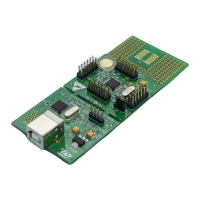Inter-integrated circuit (I
2
C) interface RM0016
278/449 Doc ID 14587 Rev 8
21 Inter-integrated circuit (I
2
C) interface
21.1 Introduction
I
2
C (inter-integrated circuit) bus interface serves as an interface between the microcontroller
and the serial I
2
C bus. It provides multi-master capability, and controls all I
2
C bus-specific
sequencing, protocol, arbitration and timing. It supports standard and fast speed modes.
21.2 I
2
C main features
● Parallel-bus/I
2
C protocol converter
● Multi-master capability: the same interface can act as Master or Slave
● I
2
C Master features:
– Clock generation
– Start and Stop generation
● I
2
C Slave features:
– Programmable I
2
C Address detection
– Stop bit detection
● Generation and detection of 7-bit/10-bit addressing and general call
● Supports different communication speeds:
– Standard speed (up to 100 kHz),
– Fast speed (up to 400 kHz)
● Status flags:
– Transmitter/receiver mode flag
– End-of-byte transmission flag
–I
2
C busy flag
● Error flags:
– Arbitration lost condition for master mode
– Acknowledgement failure after address/ data transmission
– Detection of misplaced start or stop condition
– Overrun/underrun if clock stretching is disabled
● 3 types of interrupts:
– 1 communication interrupt
– 1 error condition interrupt
– 1 wakeup from Halt interrupt
● Wakeup capability:
– MCU wakes up from Low power mode on address detection in slave mode.
● Optional clock stretching

